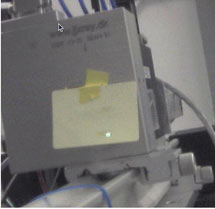
Handy Links
SLAC News Center
SLAC Today
- Subscribe
- Archives: Feb 2006-May 20, 2011
- Archives: May 23, 2011 and later
- Submit Feedback or Story Ideas
- About SLAC Today
SLAC News
Lab News
- Interactions
- Lightsources.org
- ILC NewsLine
- Int'l Science Grid This Week
- Fermilab Today
- Berkeley Lab News
- @brookhaven TODAY
- DOE Pulse
- CERN Courier
- DESY inForm
- US / LHC
SLAC Links
- Emergency
- Safety
- Policy Repository
- Site Entry Form

- Site Maps
- M & O Review
- Computing Status & Calendar
- SLAC Colloquium
- SLACspeak
- SLACspace
- SLAC Logo
- Café Menu
- Flea Market
- Web E-mail
- Marguerite Shuttle
- Discount Commuter Passes
-
Award Reporting Form
- SPIRES
- SciDoc
- Activity Groups
- Library
Stanford
Around the Bay
SSRL Beamline 14 Sees First Light
Last week, X-ray light for the first time streamed into the new Beamline 14-1 hutch at the Stanford Synchrotron Radiation Lightsource.
"When you open a beamline and see first light, there is a great feeling of relief and satisfaction," said Engineering Physicist Daniel Harrington, who served as project manager for construction of this beamline. "When the first users arrive later this year, they will conduct macromolecular crystallography experiments here, looking at what you might call the molecules of life."
Researchers use macromolecular crystallography to study the function of a large range of molecules, such as cellular proteins, DNA, and RNA macromolecules, that have biological and biomedical impact. When purified and crystallized forms of these macromolecules are placed in the beam, the crystals diffract the X-rays. This creates a pattern of X-rays that can be analyzed to determine the sample's three-dimensional structure at a level that identifies the location of each atom. This technique was used for the structural part of the work that awarded Professor Roger Kornberg the 2006 Nobel Prize.
A few months from now, Beamline 14-1 will grow to include a second branch line, 14-3, which will focus on X-ray absorption spectroscopy in the softer (longer-wavelength) X-ray energy region. Both lines 14-1 and 14-3 will add new capabilities to the overall SSRL Structural Molecular Biology program.
"Building a beamline is a complex endeavor involving the contributions of many groups at SSRL and SLAC," said Harrington. "When you work on a project for three years, it's great to see that it works as it was designed to work. A lot of people deserve praise for doing their jobs extremely well to get us to this point."
SSRL now offers users 12 beamlines with 30 experimental stations investigating various forms of matter ranging from objects of atomic and molecular size to manmade materials with unusual properties. Learn more about SSRL's beamlines online.
Most of the funding for beamline 14-1 was provided by Genentech and the Joint Center for Structural Genomics (through funding from National Institutes of Health's National Institute of General Medical Sciences’ Protein Structure Initiative). Beamline 14-3 is funded by the Department of Energy's Office of Biological and Environmental Research and Office of Basic Energy Sciences. The overall SSRL Structural Molecular Biology program is funded by DOE BER, the NIH National Center for Research Resources and the NIH NIGMS.
—Kelen Tuttle
SLAC Today, April 17, 2009
